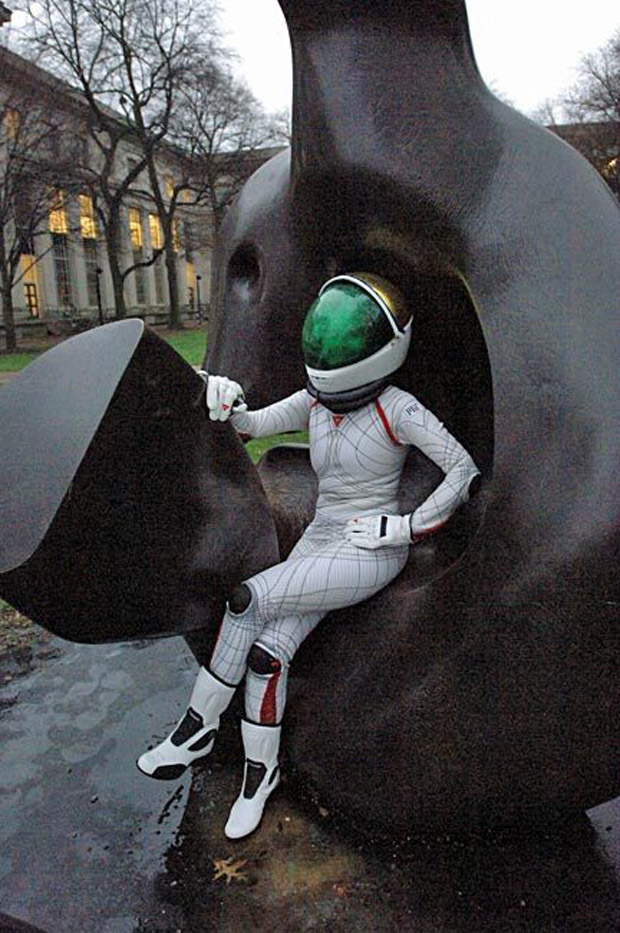Slimming Down Future Spacesuits

Skintight spacesuits may give future astronauts a moreflexible - not to mention stylish - way to explore the moon and Mars.
Researchers at the Massachusetts Institute of Technology(MIT) are edging closer to a spaceworthy astronaut garment that replaces thebulky traits of current, gas-pressurized versions with flexibilityand mobility. Dubbed BioSuit, the spacesuit design relies on mechanicalcounter pressure rather than the stiff pressurized vessels employed byastronauts in space today.
"You can't do much bending of the arms or legs in thattype of suit," said Dava Newman, an MIT professor of aeronautics andastronauts leading the research, of current spacesuits used in Earth orbit.
Newman and colleague Jeffrey Hoffman, a former NASAastronaut and spacewalker, have been working with students and the design firmTrotti and Associates for seven years to build a viable BioSuit.
Get the Space.com Newsletter
Breaking space news, the latest updates on rocket launches, skywatching events and more!
A current prototypeof the suit consistently exerts pressures of about 20 kilopascals on itswearer but newer models have reached pressures of up to 25 to 30 kilopascals,which is about one-third that of the Earth?s atmosphere and the target forspaceworthy BioSuit, researchers said. A fully functional suit could be madeready for spaceflight in about 10 years, they added.
At the heart of the BioSuit is mechanical counter pressure,which uses tightly wrapped layers of material that are both flexible andprotective to the astronaut inside. The suit?s layers are wrapped in ameticulous fashion -- based on three-dimensional maps of the human body inmotion -- to provide structural support while maintaining mobility, researcherssaid.
NASA?s current Extravehicular Mobility Unit (EMU)spacesuits, as well as their Russian Orlan counterparts, surround theirastronaut wearers in a stiff, pressurized vessel containing breathable air.Added outer layers of material, as well as a backpack-mounted life supportsystem, can further restrict the spacesuit?s mobility and require astronauts tospend the bulk of their energy fighting their own garments while toiling inspace.
Both the EMUand Orlan spacesuits are designed for work in Earth orbit, not for use onplanetary surfaces like those of the Moon or Mars, where walking -- notfloating -- will be key.
?We really must design for greater mobility and enhancedhuman and robotic capability," Newman said.
Newman hopes the BioSuits could be tailored to offer varyinglevels of resistance to their wearers for use as exercise garments forastronauts on long flights to Mars, as well as athletes and those requiring aidto walk on Earth.
The promise of mechanical counter pressure space garmentshas not missed NASA's eye.
In early May, the U.S. space agency offered up a $50,000cash prize for anyone capable of demonstrating a homebuilt version of aspacesuit glove using the technology during its Astronaut Glove Challenge. While the $50,000 prize wentunclaimed for lack of entrants and was rolled over to 2008, a $200,000 pursefor a more conventional space glove went to Maine engineer Peter Homer.
- VIDEO: All Dressed Up for Mars
- VIDEO: Future Fashion's Past
- Historic Shuttle Spacesuits to Meet Fiery End
Join our Space Forums to keep talking space on the latest missions, night sky and more! And if you have a news tip, correction or comment, let us know at: community@space.com.

Tariq is the Editor-in-Chief of Space.com and joined the team in 2001, first as an intern and staff writer, and later as an editor. He covers human spaceflight, exploration and space science, as well as skywatching and entertainment. He became Space.com's Managing Editor in 2009 and Editor-in-Chief in 2019. Before joining Space.com, Tariq was a staff reporter for The Los Angeles Times covering education and city beats in La Habra, Fullerton and Huntington Beach. In October 2022, Tariq received the Harry Kolcum Award for excellence in space reporting from the National Space Club Florida Committee. He is also an Eagle Scout (yes, he has the Space Exploration merit badge) and went to Space Camp four times as a kid and a fifth time as an adult. He has journalism degrees from the University of Southern California and New York University. You can find Tariq at Space.com and as the co-host to the This Week In Space podcast with space historian Rod Pyle on the TWiT network. To see his latest project, you can follow Tariq on Twitter @tariqjmalik.









